#national institute of fashion technology
Text
NIFT Coaching In Aashiyana - NIFT Institute In Aashiyana - NIFT Coaching Classes Online In Aashiyana - NIFT Coaching Fees In Aashiyana - ACS
NIFT (National Institute of Fashion Technology) is a prestigious institution in India that offers undergraduate and postgraduate programs in fashion and design. Getting into NIFT is a dream for many aspiring fashion designers, and the competition is fierce. As a result, many students choose to enroll in NIFT coaching in Aashiyana to improve their chances of success.
#nift#nift coaching#nift coaching fees#nift coaching in Aashiyana#nift coaching classes in Aashiyana#nift coaching online#nift Aashiyana fees#nift coaching institute in Aashiyana#nift coaching centre in Aashiyana#nift coaching fees in Aashiyana#best nift coaching in Aashiyana#nift eligibility#national institute of fashion technology
1 note
·
View note
Text
National Institute of Fashion Technology (NIFT)
We know that exam prep can be daunting, but we're here to help! Our mock exams are designed to give you the best possible preparation for your upcoming tests. With our series of exams, you can practice as much as you need to feel confident and prepared on test day. So why wait? Start your exam prep today with Edunative!
1 note
·
View note
Text
NIFT Recruitment 2023 : राष्ट्रीय फैशन प्रौद्योगिकी संस्थान भोपाल में निकली बंपर पदों पर भर्ती, नि:शुल्क करें आवेदन
राष्ट्रीय फैशन प्रौद्योगिकी संस्थान भर्ती 2023 (NIFT Recruitment 2023)
NIFT Recruitment 2023 : राष्ट्रीय फैशन प्रौद्योगिकी संस्थान (National Institute of Fashion Technology) ने भोपाल सहित अन्य स्थानों के विभिन्न पदों की पूर्ति के लिए 15 पदों पर भर्ती निकाली है। इक्छुक उम्मीदवार दिनांक 15/09/2023 से 25/10/2023 तक ऑफलाइन आवदेन कर सकते हैं।
इस भर्ती से संबंधित जानकारी जैसे:- महत्वपूर्ण तिथि,…

View On WordPress
#National Institute of Fashion Technology Vac#National Institute of Fashion Technology Vacancy 2023#NIFT Bhopal Recruitment 2023#NIFT Director Bharti 2023#NIFT Recruitment 2023
0 notes
Text
National Institute of Fashion Technology (NIFT) | JE (Civil) | Bhubaneswar | jobs
National Institute of Fashion Technology (NIFT) | JE (Civil) | Bhubaneswar | jobs
View On WordPress
#Career#Careers in National Institute of Fashion Technology (NIFT)#Current Job openins in National Institute of Fashion Technology (NIFT)#Experience in Software#Experienced Professionals#Experienced Software Jobs#freshersbazaar.com#Government jobs#IT jobs#IT/Software Jobs#JE (Civil) Jobs#job openings in National Institute of Fashion Technology (NIFT)#Jobs in National Institute of Fashion Technology (NIFT)#MBA Jobs#National Institute of Fashion Technology (NIFT)#National Institute of Fashion Technology (NIFT) Careers#National Institute of Fashion Technology (NIFT) Jobs#National Institute of Fashion Technology (NIFT)job openings#Software Experience#Software Jobs#Software Jobs for Experienced people#System.Web.UI.WebControls.TextBox Jobs#Technical Resources#Walk-ins
0 notes
Text
The CHIPS Act treats the symptoms, but not the causes

If you'd like an essay-formatted version of this post to read or share, here's a link to it on pluralistic.net, my surveillance-free, ad-free, tracker-free blog:
https://pluralistic.net/2024/02/07/farewell-mr-chips/#we-used-to-make-things

There's this great throwaway line in 1992's Sneakers, where Dan Aykroyd, playing a conspiracy-addled hacker/con-man, is feverishly telling Sydney Poitier (playing an ex-CIA spook) about a 1958 meeting Eisenhower had with aliens where Ike said, "hey, look, give us your technology, and we'll give you all the cow lips you want."
Poitier dismisses Aykroyd ("Don't listen to this man. He's certifiable"). We're meant to be on Poitier's side here, but I've always harbored some sympathy for Aykroyd in this scene.
That's because I often hear echoes of Aykroyd's theory in my own explanations of the esoteric bargains and plots that produced the world we're living in today. Of course, in my world, it's not presidents bargaining for alien technology in exchange for cow-lips – it's the world's wealthy nations bargaining to drop trade restrictions on the Global South in exchange for IP laws.
These bargains – which started as a series of bilateral and then multilateral agreements like NAFTA, and culminated in the WTO agreement of 1999 – were the most important step in the reordering of the world's economy around rent-extraction, cheap labor exploitation, and a brittle supply chain that is increasingly endangered by the polycrisis of climate and its handmaidens, like zoonotic plagues, water wars, and mass refugee migration.
Prior to the advent of "free trade," the world's rich countries fashioned debt into a whip-hand over poor, post-colonial nations. These countries had been bankrupted by their previous colonial owners, and the price of their freedom was punishing debts to the IMF and other rich-world institutions in exchange for loans to help these countries "develop."
Like all poor debtors, these countries were said to have gotten into their predicament through moral failure – they'd "lived beyond their means."
(When rich people get into debt, bankruptcy steps in to give them space to "restructure" according to their own plans. When poor people get into debt, bankruptcy strips them of nearly everything that might help them recover, brands them with a permanent scarlet letter, and subjects them to humiliating micro-management whose explicit message is that they are not competent to manage their own affairs):
https://pluralistic.net/2021/08/07/hr-4193/#shoppers-choice
So the poor debtor nations were ordered to "deregulate." They had to sell off their state assets, run their central banks according to the dictates of rich-world finance authorities, and reorient their production around supplying raw materials to rich countries, who would process these materials into finished goods for export back to the poor world.
Naturally, poor countries were not allowed to erect "trade barriers" that might erode the capacity of this North-South transfer of high-margin goods, but this was not the era of free trade. It wasn't the free trade era because, while the North-South transfer was largely unrestricted, the South-North transfer was subject to tight regulation in the rich world.
In other words, poor countries were expected to export, say, raw ore to the USA and reimport high-tech goods, with low tariffs in both directions. But if a poor country processed that ore domestically and made its own finished goods, the US would block those goods at the border, slapping them with high tariffs that made them more expensive than Made-in-the-USA equivalents.
The argument for this unidirectional trade was that the US – and other rich countries – had a strategic need to maintain their manufacturing industries as a hedge against future geopolitical events (war, but also pandemics, extreme weather) that might leave the rich world unable to provide for itself. This rationale had a key advantage: it was true.
A country that manages its own central bank can create as much of its own currency as it wants, and use that money to buy anything for sale in its own currency.
This may not be crucial while global markets are operating to the country's advantage (say, while the rest of the world is "willingly" pricing its raw materials in your country's currency), but when things go wrong – war, plague, weather – a country that can't make things is at the rest of the world's mercy.
If you had to choose between being a poor post-colonial nation that couldn't supply its own technological needs except by exporting raw materials to rich countries, and being a rich country that had both domestic manufacturing capacity and a steady supply of other countries' raw materials, you would choose the second, every time.
What's not to like?
Here's what.
The problem – from the perspective of America's ultra-wealthy – was that this arrangement gave the US workforce a lot of power. As US workers unionized, they were able to extract direct concessions from their employers through collective bargaining, and they could effectively lobby for universal worker protections, including a robust welfare state – in both state and federal legislatures. The US was better off as a whole, but the richest ten percent were much poorer than they could be if only they could smash worker power.
That's where free trade comes in. Notwithstanding racist nonsense about "primitive" countries, there's no intrinsic defect that stops the global south from doing high-tech manufacturing. If the rich world's corporate leaders were given free rein to sideline America's national security in favor of their own profits, they could certainly engineer the circumstances whereby poor countries would build sophisticated factories to replace the manufacturing facilities that sat behind the north's high tariff walls.
These poor-country factories could produce goods ever bit as valuable as the rich world's shops, but without the labor, environmental and financial regulations that constrained their owners' profits. They slavered for a business environment that let them kill workers; poison the air, land and water; and cheat the tax authorities with impunity.
For this plan to work, the wealthy needed to engineer changes in both the rich world and the poor world. Obviously, they would have to get rid of the rich world's tariff walls, which made it impossible to competitively import goods made in the global south, no matter how cheaply they were made.
But free trade wasn't just about deregulation in the north – it also required a whole slew of new, extremely onerous regulations in the global south. Corporations that relocated their manufacturing to poor – but nominally sovereign – countries needed to be sure that those countries wouldn't try to replicate the American plan of becoming actually sovereign, by exerting control over the means of production within their borders.
Recall that the American Revolution was inspired in large part by fury over the requirement to ship raw materials back to Mother England and then buy them back at huge markups after they'd been processed by English workers, to the enrichment of English aristocrats. Post-colonial America created new regulations (tariffs on goods from England), and – crucially – they also deregulated.
Specifically, post-revolutionary America abolished copyrights and patents for English persons and firms. That way, American manufacturers could produce sophisticated finished goods without paying rent to England's wealthy making those goods cheaper for American buyers, and American publishers could subsidize their editions of American authors' books by publishing English authors on the cheap, without the obligation to share profits with English publishers or English writers.
The surplus produced by ignoring the patents and copyrights of the English was divided (unequally) among American capitalists, workers, and shoppers. Wealthy Americans got richer, even as they paid their workers more and charged less for their products. This incubated a made-in-the-USA edition of the industrial revolution. It was so successful that the rest of the world – especially England – began importing American goods and literature, and then American publishers and manufacturers started to lean on their government to "respect" English claims, in order to secure bilateral protections for their inventions and books in English markets.
This was good for America, but it was terrible for English manufacturers. The US – a primitive, agricultural society – "stole" their inventions until they gained so much manufacturing capacity that the English public started to prefer American goods to English ones.
This was the thing that rich-world industrialists feared about free trade. Once you build your high-tech factories in the global south, what's to stop those people from simply copying your plans – or worse, seizing your factories! – and competing with you on a global scale? Some of these countries had nominally socialist governments that claimed to explicitly elevate the public good over the interests of the wealthy. And all of these countries had the same sprinkling of sociopaths who'd gladly see a million children maimed or the land poisoned for a buck – and these "entrepreneurs" had unbeatable advantages with their countries' political classes.
For globalization to work, it wasn't enough to deregulate the rich world – capitalists also had to regulate the poor world. Specifically, they had to get the poor world to adopt "IP" laws that would force them to willingly pay rent on things they could get for free: patents and other IP, even though it was in the short-term, medium-term, and long-term interests of both the nation and its politicians and its businesspeople.
Thus, the bargain that makes me sympathetic to Dan Aykroyd: not cow lips for alien tech; but free trade for IP law. When the WTO was steaming towards passage in the late 1990s, there was (rightly) a lot of emphasis on its deregulatory provisions: weakening of labor, environmental and financial laws in the poor world, and of tariffs in the rich world.
But in hindsight, we all kind of missed the main event: the TRIPS (Agreement on Trade-Related Aspects of Intellectual Property Rights). This actually started before the WTO treaty (it was part of the GATT, a predecessor to the WTO), but the WTO spread it to countries all over the world. Under the TRIPS, poor countries are required to honor the IP claims of rich countries, on pain of global sanction.
That was the plan: instead of paying American workers to make Apple computers, say, Apple could export the "IP" for Macs and iPhones to countries like China, and these countries would produce Apple products that were "designed in California, assembled in China." China would allow Apple to treat Chinese workers so badly that they routinely committed suicide, and would lock up or kill workers who tried to unionize. China would accept vast shipments of immortal, toxic e-waste. And China wouldn't let its entrepreneurs copy Apple's designs, be they software, schematics or trademarks.
Apple isn't the only company that pursued this strategy, but no company has executed it as successfully. It's not for nothing that Steve Jobs's hand-picked successor was Tim Cook, who oversaw the transfer of even the most exacting elements of Apple manufacturing to Chinese facilities, striking bargains with contractors like Foxconn that guaranteed that workers would be heavily – lethally! – surveilled and controlled to prevent the twin horrors of unionization and leaks.
For the first two decades of the WTO era, the most obvious problems with this arrangement was wage erosion (for American workers) and leakage (for the rich). China's "socialist" government was only too happy to help Foxconn imprison workers who demanded better wages and working conditions, but they were far more relaxed about knockoffs, be they fake iPods sold in market stalls or US trade secrets working their way into Huawei products.
These were problems for the American aristocracy, whose investments depended on China disciplining both Chinese workers and Chinese businesses. For the American people, leakage was a nothingburger. Apple's profits weren't shared with its workforce beyond the relatively small number of tech workers at its headquarters. The vast majority of Apple employees, who flogged iPhones and scrubbed the tilework in gleaming white stores across the nation, would get the same minimal (or even minimum) wage no matter how profitable Apple grew.
It wasn't until the pandemic that the other shoe dropped for the American public. The WTO arrangement – cow lips for alien technology – had produced a global system brittle supply chains composed entirely of weakest links. A pandemic, a war, a ship stuck in the Suez Canal or Houthi paramilitaries can cripple the entire system, perhaps indefinitely.
For two decades, we fought over globalization's effect on wages. We let our corporate masters trick us into thinking that China's "cheating" on IP was a problem for the average person. But the implications of globalization for American sovereignty and security were banished to the xenophobic right fringe, where they were mixed into the froth of Cold War 2.0 nonsense. The pandemic changed that, creating a coalition that is motivated by a complex and contradictory stew of racism, environmentalism, xenophobia, labor advocacy, patriotism, pragmatism, fear and hope.
Out of that stew emerged a new American political tendency, mostly associated with Bidenomics, but also claimed in various guises by the American right, through its America First wing. That tendency's most visible artifact is the CHIPS Act, through which the US government proposes to use policy and subsidies to bring high-tech manufacturing back to America's shores.
This week, the American Economic Liberties Project published "Reshoring and Restoring: CHIPS Implementation for a Competitive Semiconductor Industry," a fascinating, beautifully researched and detailed analysis of the CHIPS Act and the global high-tech manufacturing market, written by Todd Achilles, Erik Peinert and Daniel Rangel:
https://www.economicliberties.us/our-work/reshoring-and-restoring-chips-implementation-for-a-competitive-semiconductor-industry/#
Crucially, the report lays out the role that the weakening of antitrust, the dismantling of tariffs and the strengthening of IP played in the history of the current moment. The failure to enforce antitrust law allowed for monopolization at every stage of the semiconductor industry's supply-chain. The strengthening of IP and the weakening of tariffs encouraged the resulting monopolies to chase cheap labor overseas, confident that the US government would punish host countries that allowed their domestic entrepreneurs to use American designs without permission.
The result is a financialized, "capital light" semiconductor industry that has put all its eggs in one basket. For the most advanced chips ("leading-edge logic"), production works like this: American firms design a chip and send the design to Taiwan where TSMC foundry turns it into a chip. The chip is then shipped to one of a small number of companies in the poor world where they are assembled, packaged and tested (AMP) and sent to China to be integrated into a product.
Obsolete foundries get a second life in the commodity chip ("mature-node chips") market – these are the cheap chips that are shoveled into our cars and appliances and industrial systems.
Both of these systems are fundamentally broken. The advanced, "leading-edge" chips rely on geopolitically uncertain, heavily concentrated foundries. These foundries can be fully captured by their customers – as when Apple prepurchases the entire production capacity of the most advanced chips, denying both domestic and offshore competitors access to the newest computation.
Meanwhile, the less powerful, "mature node" chips command minuscule margins, and are often dumped into the market below cost, thanks to subsidies from countries hoping to protect their corner of the high-tech sector. This makes investment in low-power chips uncertain, leading to wild swings in cost, quality and availability of these workhorse chips.
The leading-edge chipmakers – Nvidia, Broadcom, Qualcomm, AMD, etc – have fully captured their markets. They like the status quo, and the CHIPS Act won't convince them to invest in onshore production. Why would they?
2022 was Broadcom's best year ever, not in spite of its supply-chain problems, but because of them. Those problems let Broadcom raise prices for a captive audience of customers, who the company strong-armed into exclusivity deals that ensured they had nowhere to turn. Qualcomm also profited handsomely from shortages, because its customers end up paying Qualcomm no matter where they buy, thanks to Qualcomm ensuring that its patents are integrated into global 4G and 5G standards.
That means that all standards-conforming products generate royalties for Qualcomm, and it also means that Qualcomm can decide which companies are allowed to compete with it, and which ones will be denied licenses to its patents. Both companies are under orders from the FTC to cut this out, and both companies ignore the FTC.
The brittleness of mature-node and leading-edge chips is not inevitable. Advanced memory chips (DRAM) roughly comparable in complexity to leading-edge chips, while analog-to-digital chips are as easily commodified as mature-node chips, and yet each has a robust and competitive supply chain, with both onshore and offshore producers. In contrast with leading-edge manufacturers (who have been visibly indifferent to the CHIPS incentives), memory chip manufacturers responded to the CHIPS Act by committing hundreds of billions of dollars to new on-shore production facilities.
Intel is a curious case: in a world of fabless leading-edge manufacturers, Intel stands out for making its own chips. But Intel is in a lot of trouble. Its advanced manufacturing plans keep foundering on cost overruns and delays. The company keeps losing money. But until recently, its management kept handing its shareholders billions in dividends and buybacks – a sign that Intel bosses assume that the US public will bail out its "national champion." It's not clear whether the CHIPS Act can save Intel, or whether financialization will continue to hollow out a once-dominant pioneer.
The CHIPS Act won't undo the concentration – and financialization – of the semiconductor industry. The industry has been awash in cheap money since the 2008 bailouts, and in just the past five years, US semiconductor monopolists have paid out $239b to shareholders in buybacks and dividends, enough to fund the CHIPS Act five times over. If you include Apple in that figure, the amount US corporations spent on shareholder returns instead of investing in capacity rises to $698b. Apple doesn't want a competitive market for chips. If Apple builds its own foundry, that just frees up capacity at TSMC that its competitors can use to improve their products.
The report has an enormous amount of accessible, well-organized detail on these markets, and it makes a set of key recommendations for improving the CHIPS Act and passing related legislation to ensure that the US can once again make its own microchips. These run a gamut from funding four new onshore foundries to requiring companies receiving CHIPS Act money to "dual-source" their foundries. They call for NIST and the CPO to ensure open licensing of key patents, and for aggressive policing of anti-dumping rules for cheap chips. They also seek a new law creating an "American Semiconductor Supply Chain Resiliency Fee" – a tariff on chips made offshore.
Fundamentally, these recommendations seek to end the outsourcing made possible by restrictive IP regimes, to undercut Wall Street's power to demand savings from offshoring, and to smash the market power of companies like Apple that make the brittleness of chip manufacturing into a feature, rather than a bug. This would include a return to previous antitrust rules, which limited companies' ability to leverage patents into standards, and to previous IP rules, which limited exclusive rights chip topography and design ("mask rights").
All of this will is likely to remove the constraints that stop poor countries from doing to America the same things that postcolonial America did to England – that is, it will usher in an era in which lots of countries make their own chips and other high-tech goods without paying rent to American companies. This is good! It's good for poor countries, who will have more autonomy to control their own technical destiny. It's also good for the world, creating resiliency in the high-tech manufacturing sector that we'll need as the polycrisis overwhelms various places with fire and flood and disease and war. Electrifying, solarizing and adapting the world for climate resilience is fundamentally incompatible with a brittle, highly concentrated tech sector.
Pluralizing high-tech production will make America less vulnerable to the gamesmanship of other countries – and it will also make the rest of the world less vulnerable to American bullying. As Henry Farrell and Abraham Newman describe so beautifully in their 2023 book Underground Empire, the American political establishment is keenly aware of how its chokepoints over global finance and manufacturing can be leveraged to advantage the US at the rest of the world's expense:
https://pluralistic.net/2023/10/10/weaponized-interdependence/#the-other-swifties
Look, I know that Eisenhower didn't trade cow-lips for alien technology – but our political and commercial elites really did trade national resiliency away for IP laws, and it's a bargain that screwed everyone, except the one percenters whose power and wealth have metastasized into a deadly cancer that threatens the country and the planet.

Image:
Mickael Courtiade (modified)
https://www.flickr.com/photos/197739384@N07/52703936652/
CC BY 2.0
https://creativecommons.org/licenses/by/2.0/
#pluralistic#chips act#ip#monopolies#antitrust#national security#industrial policy#american economic liberties project#tmsc#leading-edge#intel#mature node#lagging edge#foundries#fabless
251 notes
·
View notes
Text



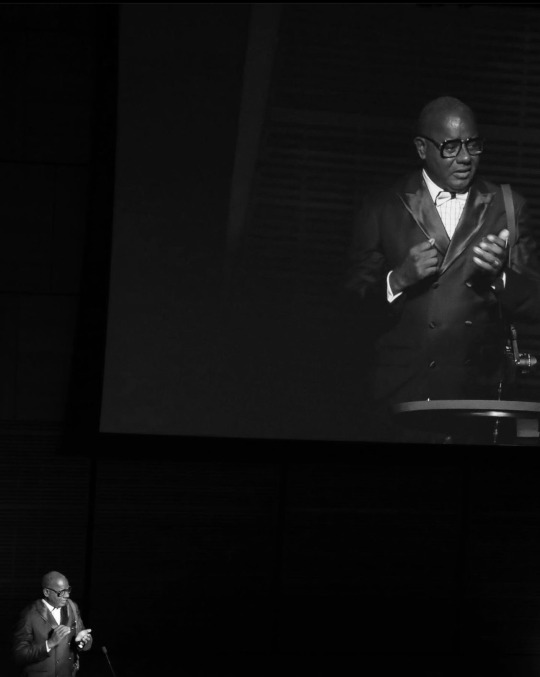
What an EPIC night, Brother Jamel Shabazz received the prestigious @luciefoundation Award presented by Peter Kunhardt, Jr. Executive Director for The Gordon Parks Foundation at Carnegie Hall… So well deserved.
Jamel Shabazz is best known for his iconic photographs of New York City during the 1980s. A documentary, fashion, and street photographer, he has authored 12 monographs and contributed to over three dozen other photography related books.
His photographs have been exhibited worldwide and his work is housed within the permanent collections of The Whitney Museum, The Brooklyn Museum, The Studio Museum in Harlem, The Smithsonian’s National Museum of African American History and Culture, The Fashion Institute of Technology, The Art Institute of Chicago and the Getty Museum.
Over the years, Shabazz has instructed young students at the Studio Museum in Harlem’s “Expanding the Walls” project, The Schomburg Center for Research in Black Culture “Teen Curator’s” program, and the Bronx Museum’s “Teen Council.” He is also the 2018 recipient of the Gordon Parks award for excellence in the arts and humanitarianism and the 2022 awardee of the Gordon Parks Foundation/Steidl book prize. His goal as an artist is to contribute to the preservation of world history and culture.
It is an honor to collaborate with Brother Jamel Shabazz on the @albeesquaremall book that has been years in the making.
Another one of Brooklyn’s Finest 👑🏆🫡 @jamelshabazz
CARTER™️ Magazine
#carter magazine#carter#historyandhiphop365#wherehistoryandhiphopmeet#history#cartermagazine#today in history#staywoke#blackhistory#blackhistorymonth#jamel shabazz
31 notes
·
View notes
Note
what are your go-to resources for phantom blood fashion historical accuracy...... ...
ok I'm glad you asked this because I've been writing up a whole other post on dio's fashion sense and i wasn't sure how much of the period's fashion trends to explain since I didn't want to make an assumption that nobody knows anything about late victorian fashion. this will be a good reference post for me...and you... and anyone else who wants to use it.
regardless; I hate to say it but the best way to start drawing period clothing is to do a little reading on the fundamentals of [late] victorian dress because it will seriously assist you in the long run, e.g., you won't have to scratch your head and spend time wondering why you keep coming across two different lapel types on tailcoat fashion plates if you're aware that both peak tips and shawl collars were in vogue in the late 1880s and the '90s.
I'll put some basic information that I've collected for myself here so you don't have to go looking for it; I'm going to write this assuming you're a newborn baby deer poking your nose into the victorian era for the first time in your life fully unaware of the customs.
reference links for the wayfarer so you don't have to scroll all the way to the bottom:
Etiquette books. Look for anything written in the 80s/90s; again, period trends change. There's usually always a section on how men should be dressing on different occasions (weddings, funerals, daily casual travel, etc.) in these. In an ideal world one would only have to reference books written/published in London, however I've found that there are many more from US. This is fine though IMO, there was a lot of cross-talk between countries due to the implementation of the telegraph and hence a lot of etiquette standards are "universal" (it's why fashion between EU/US/AU can look pretty similar at the same time--they were all talking to each other). If there's a difference between the "New York" way of doing things and the "London" way of doing things, the authors usually point this out. kind of funny. I love reading these, they're also very good for understanding the general quirks of late Victorian society and how the standards at the time characterize their behavior.
The National Portrait Gallery (link is an advanced search; you can change the dates. I set the results to be located in "london")
Victoria & Albert museum online gallery
The Met museum online gallery (in general for clothes on mannequins, but they also list an archive of fashion plates here, separated by year. A lot of them are misfiled though so be wary of that)
Alamy website. genuinely one of the most all-encompassing resources I've used, I use it for everything and especially when I'm into period pieces. "boy 188*" "man 1880s portrait" "man 188* suit" etc. you find a lot of illustrations from the time period this way too. it fucking rules. my computer is on the brink of crashing 24/7 because I keep too many alamy tabs open at all times. A lot of really good Vanity Fair illustrations are on here too, just plug it in with a year and see what pops up.
Sites like this (Gentleman's Gazette) with little articles giving a run-down of period clothing can be helpful...... to an extent. idk. I don't really trust them. GG is solid for the most part and so is The Black Tie Blog and Victorian Web, but I've spotted too many errors on other sites to trust anything they say wholesale. Fashion Institute of Technology is worth mentioning as well, though, despite their coverage on men's fashion being pretty brief. Goes by decade, though, with a lot of information on women/children's fashion, too (it's very interesting! I linked their 1880s fashion rundown, highly recommend going through it, especially the Aestheticism segment). TL;DR: My advice when it comes to website hopping is "stick with primary sources".
How to Read a Suit (A Guide to Changing Men’s Fashion from the 17th to the 20th Century) by Lydia Edwards. Look this up on libgen. It's broken down into chunks of decades; REAAALLLYY recommend reading the introduction to "Chapter 4: 1860-1899". Probably the most historically informative consolidation of relevant fashion information in one place. Very interesting writing, pretty short too. If you're gonna read one thing out of this whole list, make it this.
The Dictionary of Fashion History by Valerie Cumming. look this up on libgen. for when you don't understand what some article or book is talking about and google will not give you answers. as it is it wont to do. (could not wrap my head around top frocks until this point; the wikipedia article for it is quite frankly embarrassing.)
here's my google drive of fashion for this time period, I had just been keeping these on local folders but I think drive would be better so I started transferring them here... compiled myself. this is a "work in progress" and will be updated.
I am going to write a bit about men's fashion at the time period under the cut because I think it's important to understand, if you don't know much about the victorian period, that the dress decorum was heavily emphasized and if you wore the wrong ensemble in the wrong setting everyone WOULD think you were ill-bred and would not invite you back into their home again. because just seeing you exist like that was impolite and quite frankly very embarrassing to witness. these resources are great but not if you don't know where and when these guys would be wearing these things... for instance i know the fashion plate archive there are some drawings of men in livery and you may be tempted to put dio in something like this because WOW! they do look kind of cool. with the big brass buttons... but I think he would more readily batter another human being physically than dress up like a butler at a dinner party and get mistaken for a butler. it's the little things.
first thing: you were expected to dress differently for different times of day. This consists of: morning dress, afternoon dress (semi-formal; not really "mandatory" except at special events, like weddings, at least for men), and evening dress (anything past 6 o'clock or "by candle light" is the general rule).

here are overview excerpts from Modern Etiquette in Public and Private published by Frederick Warne and Co. in 1887:

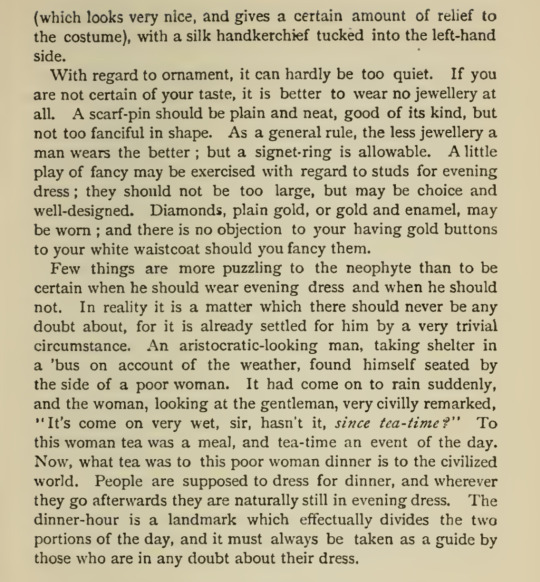
and excerpts from The Complete Bachelor: Manners for Men by Walter Germain, written in 1896:


Cecil B. Hartley states in his Book of Etiquette and Manual of Politeness (1860) that "by dress we show our respect for society at large, or the persons with whom we are to mingle".
He advised men that there were “shades of being ‘dressed;’ and a man is called ‘little dressed,’ ‘well dressed,’ and ‘much dressed,’ not according to the quantity but the quality of his coverings.”
Black was "the" color. As Lydia Edwards writes in How to Read a Suit (2020), "while it is unrealistic to imagine that all men everywhere only wore black, the acceptable color palette was certainly more limited at this point than it had been for the first half of the century. The rising professional middle classes seemed to embrace a centuries-old association with black for certain professions, which perhaps made this an inevitable choice for the evolving and expanding world of work in the nineteenth century."
I'm going to add illustrations now; humbly request you ignore how terrible the paint canvases i threw things in. Things to note moving forward:
there were three different types of shirt collars in vogue at the time: stiff, high stand collars that hugged your neck, wing-tip collars, and one that's closer to the "regular" collars you typically see nowadays (banker collar). don't really see the last one in any of the fashion plates but you do see it in portraits.
Do note that walking sticks were commonplace and in fact expected to be touted around, hence why they (in addition to umbrellas) keep reappearing in the illustrations;



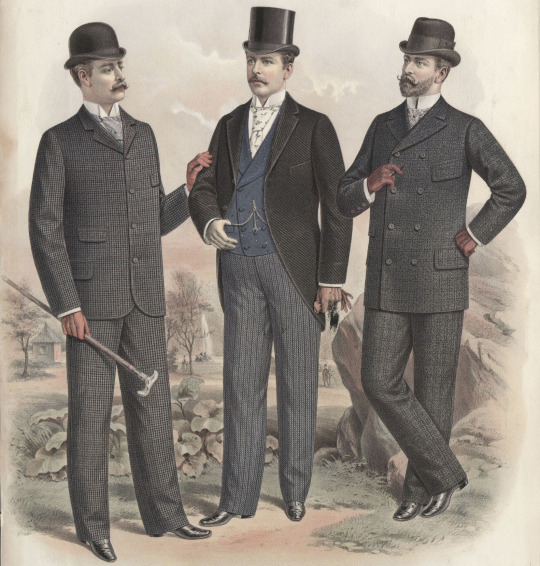
(1890)
Frock coats were the most "formal" of the daywear. When going through the National Portrait Gallery website you'll notice that most men are wearing either a morning coat or frock coat; the lounge coat was still too informal to be considered for how much money you'd spend to get a photograph taken. Don't you want to look nice?

Lounge suits, again, were the ultimate "informal"; they were viewed with distain by the frock-coat. (here's a good thread on this, actually; i love this fucking guy lol). really, really don't think Dio would be wearing one that often. maybe a double-breasted one? i really think he's too much of a snob to wear what he sees as filthy poor people rags. appearance is everything, etc.
~~~
waistcoats you have a lot of freedom/liberty with, at least in regard to design (except for evening waistcoats). different lapel shapes, no lapels... unfortunately shifting into the later decades of the 19th century it was pretty much expected that the fabric of your waistcoat match the fabric of your suit (along with your trousers; called a "ditto suit"). jonathan would conform to this mode IMO, i don't think it stops dio. he has a vision & his waistcoats are likely very extensively detailed. actually I just remembered that we do see one as depicted by araki's tenuous grasp of historical fashion and it is. awesome. i, too, love to wear cravats directly underneath my shirt


(1891 / 1892)
~~~
Evening dress is (comparatively) much more simple & men had much less artistic freedom in their choice of dress: black tailcoat, white gloves, white tie, waistcoat in either black or white, black button boots. Regardless, it was its own beast in the fact that this was something that you really weren't supposed to dick around with. (Dio would've found a way, but that's a discussion for a post that isn't crashing every 3 minutes.) From A Gentleman by Maurice Francis Egan (1893):
If a young man is invited to a dinner or to a great assembly in any large city, he must wear a black coat. A gray or colored coat worn after six o’clock in the evening, at any assembly where there are ladies, would imply either disrespect or ignorance on the part of the wearer. In most cities he is expected to wear the regulation evening dress, the “swallow-tail” coat of our grandfathers, and, of course, black trousers and a white tie. In London or New York or Chicago a man must follow this last custom or stay at home. He has his choice. The “swallow-tail” coat is worn after six o’clock in the evening, never earlier, in all English-speaking countries.
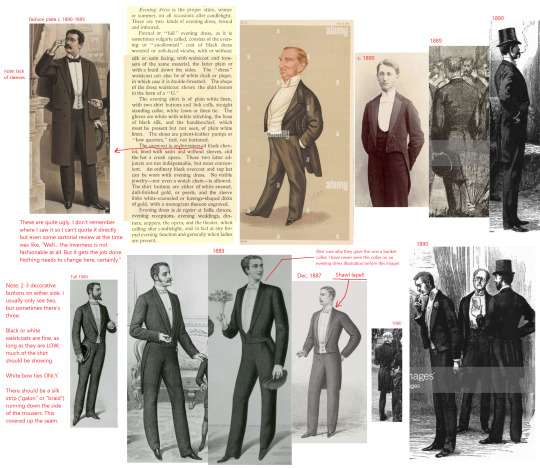
(1885 (misfiled) / 1888 / 1888 / 1890)



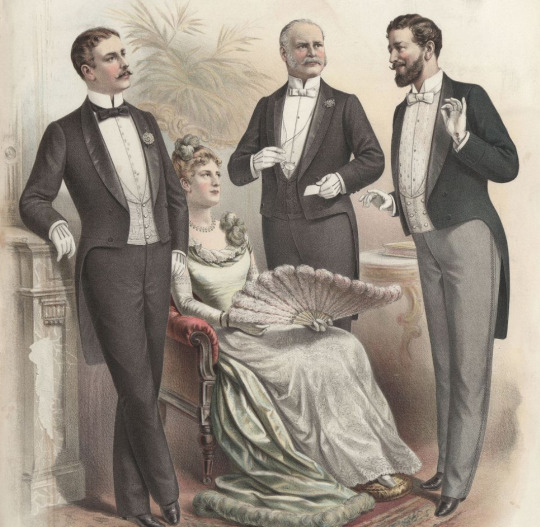
MET evening suit ca. 1888; different aspects of the ensemble displayed solo at this link.
In the 80s the "dinner jacket" ("tuxedo" in US) was introduced. It was used for more informal occasions.

final evening dress "tips":


~~~
Outerwear was pretty varied… you can get a pretty wide dynamic of form depending on choice of coat, so keep that in mind. chesterfields tended to be pretty formless, top frocks a bit more fitted. Length/density would change depending on season, too.


~~~
Children's fashion:

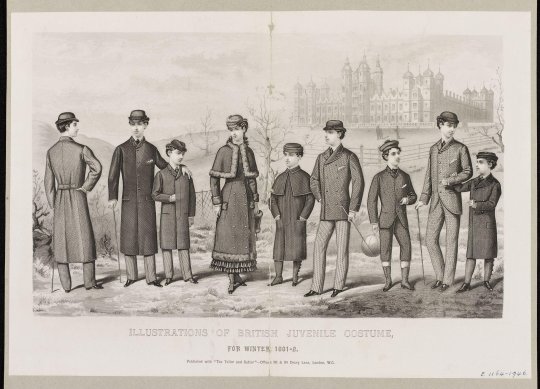
end notes:
everyone would be wearing suspenders, not belts; belts were pretty much only worn with military uniform at this time (except in america)
sweater vests were really only considered sportswear until the first few decades of the 1900s. they would not be wearing these casually under jackets, they'd be wearing waistcoats
button boots were buttoned using a special button hook. video demonstration
NOTE: trousers being "creased" began to be more in vogue in the 90s; this is because they finally invented the trouser press. read article for more information--you sometimes see creases in the 80s, really not before then though. look at how they bunch at the knee (c.1880s)!

When it comes to gloves, different colors denoted different occasions to wear them. In the text screenshots provided in previous sections, it usually states which colors are appropriate for whichever situation. The paragraph I am about to end this on is relatively useless, but I thought I'd include it anyway:

#ask#dio brando#jonathan joestar#phantom blood#I make myself sick going through fashion plates and the costume archives on museum websites identifying dio outfits regularly#that one image in the frock coat graphic reminds me so much of jeremy strong...kendall will get his day on ottiliere someday. but not today#I'll probably add to this post as I remember or discover more things to add. we're all on a journey of learning...together#posts that crashed one million times while editing#there was a lot more I wanted to add to this but every time i click something in here the entire post crashes. so i am leaving it#also FYI: i don't have a degree in this or nothing. I am a hobbyist victorian enthusiast. don't think anything is wrong in here especially#considering I cite sources but yaknow. <-disclaimer
55 notes
·
View notes
Text
2024 is a big election year for the world: More than 50 countries are expected to hold national polls, including large but profoundly damaged democracies such as India, Indonesia, and the United States. Anxieties abound that social media, further weaponized with artificial intelligence, will play a destructive role in these elections.
Pundits have worried that technology might doom democracy since Donald Trump’s election as U.S. president in 2016. It’s true that social media can benefit aspiring autocrats. Populists in particular latch on to social media today as a way to connect directly with people, bypassing restraints on their behavior that political parties would have provided in the pre-internet age. They can also profit from echo chambers, which reinforce the sense that a whole people uniformly supports a populist leader.
Yet social media is not inherently populist. And if populists do well this year, it will not be because there are no tools or strategies to stop them.
To combat populism, democracies need political will. They must not only push for better platform design and regulation but also work to strengthen what some consider a thoroughly old-fashioned institution: political parties that have the capacity to rein in leaders threatening democracy.
Every media revolution in history has caused a moral panic: The printing press was said to have prompted wars of religion; radio gave the world Adolf Hitler; TV enabled McCarthyism. None of these points, still repeated by sophisticated observers today, is completely wrong. But in every case, the technological determinism proved mistaken, as did the assumption that new media would empower irrational masses, always ready to be seduced by demagogues.
At first, social media was greeted with great optimism. In what now feels like a different era, promoters of democracy looked to Twitter (now known as X) and Facebook as tools to help uprisings against autocrats everywhere. But just as the Arab Spring turned to Arab Winter, enthusiasm morphed into pessimism. Panic ensued in 2016, after the double shock of Brexit and Trump’s election. Liberal commentators were quick to identify what they saw as a major culprit of the world’s twin populist disasters: social media and, in particular, echo chambers. Not only did liberals veer from cheering to jeering. They also indulged in nostalgia for a supposedly golden age of responsible gatekeeping by journalists. The wild swings in opinion and the idealization of the past were signs that we have yet to find our bearings when making sense of new media.
Social scientists today know a bit more than they did in 2016: Filter bubbles—or online echo chambers curated by algorithms—exist but are much less common than often assumed; they are not the main cause of polarization, even as they help spread disinformation and propaganda more swiftly; and our offline life is in many ways less diverse than our online existence.
What makes social media unique is that it allows for what can seem like a direct connection between political leaders and potential followers. This is particularly useful for populists, who claim that only they can represent what they often call the “real people.” This implies that all other contenders for power do not represent the people, since, as the usual charge goes, they are corrupt. It also implies that some citizens are not part of the “real people” at all. Think of Trump complaining that his critics are not just wrong about policy but that they are “un-American” or even—as he put it at a Veterans Day rally last year—“vermin.” The point of populism, then, is not just criticism of elites. After all, finding fault with the powerful is often justified. Instead, the point is to exclude people from the people: other politicians at the level of party politics and entire groups—usually already vulnerable ones, such as Muslims in India—at the level of the citizenry.
This seemingly direct connection contributes to the erosion of political parties. Populism is about denying and, eventually, destroying pluralism; well-functioning parties can push back against this and rein in populist political entrepreneurs. Some countries even require parties by law to have internal democratic structures. (The radical right-wing Dutch populist Geert Wilders’s Party for Freedom, which won the most seats in last November’s elections, would not be allowed in those countries because Wilders is the only official member.) Of course, parties unite partisans. But partisans often disagree on how principles they share should translate into policy. There is nothing strange about parties forming legitimate opposition to their leadership, and it has often proved crucial in providing a check on leaders. There’s a reason that populists such as Indian Prime Minister Narendra Modi and Hungarian Prime Minister Viktor Orban run their parties in a highly autocratic fashion.
To be sure, the sense of directness created by social media is an illusion. Social media mediates, after all. Yet the prospect of an unfiltered encounter—however misguided—promises authenticity and a sense of connection that was once available only at exceptional moments, such as at a party meeting or mass rally. The political theorist Nadia Urbinati has suggested the paradoxical-sounding term “direct representation” for this relationship: Anyone standing between citizens and their representatives seems to have disappeared.
The work of getting people to the polls used to be done differently. As the political scientist Paul D. Kenny explains in his book Why Populism?, before the age of social media, mobilization depended on clientelism or a well-organized (put more bluntly: highly bureaucratized) political party. Parties and candidates promised supporters material benefits or bureaucratic favors in exchange for votes. This was costly, and costs would rise steeply if political competition intensified or more power brokers entered the fray. Bureaucratic parties are also expensive to maintain. Party officers have to be paid, even if they can count on volunteer work from idealists who sacrifice their weekends to distribute leaflets or canvass door-to-door.
As Kenny points out, social media cuts the costs of mobilization, especially for celebrity candidates such as Trump, who can draw on their pop culture credit. In the old days, when print and TV were dominant, propaganda feedback loops would have been constructed at great costs by party strategists; today, they are created for free by companies that want to maximize engagement for the sake of profit.
As with influencers, a politician’s online presence requires constant curation, so it is not entirely costless. Trump might have written his own tweets, spelling mistakes and all, but others need to pay tech-savvy teams. Social media might work best for those who already treat parties as instruments for marketing a personality rather than developing policy. Take former Italian Prime Minister Silvio Berlusconi, whose public relations specialists created the Forza Italia party for him in the 1990s and organized it like a fusion of soccer fan club and business enterprise. It is not an accident that Berlusconi joined TikTok before the most recent Italian elections in 2022 (even if the ragazzi he tried to appeal to might have found his performance, as young adults would say, cringe).
The most successful politicians can tap into both forms of support. For instance, Modi, with his enormous cult of personality, has emerged from a mass membership party with a bureaucratic apparatus and can rely on the free labor of partisan foot soldiers. Yet he has also built a following online, where he has been able to present himself as a celebrity above party politics.
Once populist leaders establish the illusion of direct connection, they find it easier to discredit traditional mediators, such as professional journalists, by claiming that they distort politicians’ messages. That can translate into fewer pluralistic debates and fewer opportunities for reporters to ask inconvenient questions. Modi and Orban have not held a genuine press conference in many years; Trump and Israeli Prime Minister Benjamin Netanyahu have declined to join debates before elections. Trump’s refusal to appear onstage with current Republican candidates might seem like a risky gamble: As candidate Ron DeSantis has tried to point out, the front-runner seems afraid to engage the rest of the pack; plus, he’s losing an opportunity to fully display his knack for the memorable put-down. But Trump is following the autocrat’s playbook: to appear above the fray and portray yourself as the unique embodiment of the popular will. Why stoop to the level of the competition if you’ve already told your supporters that everyone else is corrupt or, at the least, completely unrepresentative of their views?
Filter bubbles can therefore help populists sell their core product: the notion of a homogeneous people united behind the populist leader. Algorithmic curation designed to increase engagement with like-minded users amplifies this dynamic. Platforms often suggest what to watch or click on next. Anyone looking up Orban on X, for instance, will likely find an assortment of far-right content. When I recently checked his account, I was shown tweets from the Russian foreign ministry and U.S. presidential candidate and conspiracy theorist Robert F. Kennedy Jr.
To be sure, these online bubbles do not form in a vacuum. In the United States, plenty of people do live in a far-right bubble, without any contact even with center-right outlets such as the Wall Street Journal. This bubble is not the result of Facebook or X, however. As social scientists at Harvard University demonstrated in a 2018 study, its contours were shaped by the enormous success of right-wing cable news and talk radio in the 1990s. Social media just came on top of that infrastructure. If social media itself made for a world where conspiracy theories and hate always reign, we would see the same outcome in every country—but we don’t.
Democracies must overhaul how platforms are governed to make it harder for populists to use them to their advantage. One problem with social media in its current form is that it gives too much power to a few people. Platform power—the control over the means of connecting with others online—is today’s great unchecked power. As the social scientist Michael Seemann has written, platform power stems from the ability to give access to platforms or deny it, either through outright bans or harassment from online trolls.
As Elon Musk’s changes at Twitter have demonstrated, those who control platforms and their underlying machinery can manipulate online discourse. Since he took over the platform in 2022, Musk has not only arbitrarily suspended journalists but also weakened the rules—and reduced staffing—for content moderation. As Musk has replatformed white supremacists and other hatemongers, minorities such as transgender people have become less protected.
In halfway-functioning democracies, capricious oligarchs such as Musk get to govern platforms almost singlehandedly. In countries on the path to autocracy, the state itself can successfully pressure platforms to do its bidding, as India has done with Twitter by forcing it to block politicians, activists, and even the BBC. In outright autocracies, governments are perfecting what the social scientist Margaret Roberts has called friction and flooding. Rather than simply rely on fear created by widespread repression, as traditional dictatorships would, autocracies now “flood” the web with information to distract users and use intentional technical glitches (“friction”) to make it more difficult for citizens to access certain sites. These regimes know that censorship can draw attention to scandalous content; the truly savvy make it disappear. Such techniques are ubiquitous in China, as is surveillance. Aspiring autocrats, including right-wing populists vying for power in democracies, will no doubt try to copy this repertoire.
To be sure, populists cannot be prevented from building their own counter-publics online, just as parties cannot—and should not—be hindered as they bring together followers. Freedom to assemble and associate means that like-minded people have every right to get together with others who share the same commitments. One would not want authorities to start shutting down safe spaces for groups devoted to empowering minorities, for instance, just because they happen to be insufficiently pluralistic. Ideas to combat online homogeneity through injecting viewpoint diversity into online life are well intentioned but impractical. The jurist Cass Sunstein, for example, has suggested a “serendipity button,” which could very well come out as, “Now that you’re looking at the feminist viewpoint, how about clicking on the anti-feminist one?”
A more nuanced view of online political life does not mean that democracies must tolerate the incitement of hatred. Platform design makes a difference: As the political scientist Jennifer Forestal has shown, Reddit, for instance, makes for a more diverse conversation than Facebook Groups. Reddit allows for communities to form but keeps borders between subreddits permeable; it also empowers both moderators and users to stick to rules agreed on by an online community.
Content moderation in particular should be mandatory, as it is in Germany, rather than a luxury that a platform controller such as Musk has the power to dispense. Moderation can be abused, but that is the case with any attempt to control media power. (Libel laws can be—and are—exploited by undemocratic actors, but that does not mean we should dispense with them altogether.) To forestall this, content moderation must be as transparent as possible and subject to proper oversight; the “black boxes” of algorithms should be opened at least to researchers so that they can help policymakers understand how social media platforms are run. This might sound like a pipedream. But the European Union has been pursuing these goals with its recent Digital Services Act and Digital Markets Act, which so far have prevented Facebook from launching its X clone, Threads, in the bloc due to its failure to comply with privacy regulations.
Legislation and education will be important tools for democracies. The business models of social media, which are based on maximizing engagement through offering ever more extremist content, are not beyond political regulation. Democracies should also invest serious resources in teaching media literacy—something that many leaders affirm in the abstract but that, just like civic education, always gets short shrift in the end, since “hard” subjects such as math are seen as more important for global economic competition. Not least, democracies must not treat social media in isolation. If they foster a healthier media landscape, including by reinvigorating local journalism, and regulate political parties, it will be much harder for populists to succeed.
10 notes
·
View notes
Text
THIS DAY IN GAY HISTORY
based on: The White Crane Institute's 'Gay Wisdom', Gay Birthdays, Gay For Today, Famous GLBT, glbt-Gay Encylopedia, Today in Gay History, Wikipedia, and more … November 23


1876 – Manuel De Falla, Spanish composer, born (d.1946); Pablo Picasso is quoted as saying that he considered de Falla the shyest man he had ever met, "even smaller than myself, and as modest and withdrawn as an oyster shell ..." He was said to have been involved in a ménage á trois with composer Maurice Ravel and pianist Ricardo Viñes.
De Falla became close friends with Diaghalev and Massine, with whom he collaborated on The Three-Cornered Hat. It was, incidentally, immediately after the first performance of this ballet, that Massine announced his engagement to Lydia Sokolova, who had just performed the leading role, and was then dismissed from the Ballet Russes by the enraged Diaghelev.


1924 – The famed British-American anthropologist Colin Turnbull was born on this date (d.1994). Best known for this groundbreaking books The Forest People & The Mountain People, Turnbull was also one of the first anthropologists to work in the field of ethnomusicology.
Turnbull was an unconventional scholar who rejected neutrality. He idealized the BaMbuti and reviled the Ik, and described the latter as lacking any sense of altruism, in that they force their children out of their homes at the age of three, and gorge on whatever occasional excesses of food they might find until they became sick, rather than save or share. However, several anthropologists have since argued that a particularly serious famine suffered by the Ik during the period of Turnbull's visit may have distorted their normal behavior and customs, and some passages in his book make it clear that the behavior and customs of the Ik during the period he describes were drastically different from what was normal for them before they were uprooted from their original way of life.

Turnbull with MButi children.
In the US, he lived with his professional collaborator and partner of 30 years, the African American Dr. Joseph Towles, as an openly gay, interracial couple in one of the most conservative areas of the 1960s - rural Virginia.
During this time he also took up the political cause of death row inmates. After his partner's death in 1988, Turnbull, strongly affected, gave all his belongings to the United Negro College Fund. In 1989, he moved to Bloomington, Indiana to participate to the building of Tibetan Cultural Center with his friend Thupten Jigme Norbu, elder brother of the 14th Dalai Lama. In 1991 - 1992, he moved to Dharamsala, India where he took the monks' vow of Tibetan Buddhism, given to him by the Dalai Lama. He was then given a buddhist name.
He died in Virginia in 1994, aged 69. Both Towles and Turnbull died from complications of AIDS.


1933 – The New York tabloid Broadway Brevities, under the headline "Fags Tickle Nudes," published an article warning that "Pansy men of the nation" were invading steam baths and turning them into replicas of the orgy houses in Rome at the time of Nero.


Joe Zee (R) and husband Rob Younkers
1968 – Joe Zee is a Hong Kong-born Canadian fashion stylist, journalist, and producer, known for Entertainment Tonight (1981), FABLife (2015) and Celebrity Style Story (2012). Zee served as creative director of Elle for seven years. He became editor-in-chief and executive creative officer of Yahoo! Style in April 2014. He resigned from Yahoo in June 2017.
Zee was born in Hong Kong and at the age of one, moved to Toronto where he grew up. He began working in fashion in 1990, at age 22, and ultimately moved to New York City enrolling at the Fashion Institute of Technology.
In the mid-1990s, Zee met stylist Lori Goldstein at an Allure party, and soon became her assistant.
He was described in a New York Times profile as a leader in the mass market and digital transformation of fashion: "a chatty and approachable ambassador of fashion who has aggressively thrust himself in front of hoi polloi using Twitter, blogs, v-logs and—most visibly—television."
Zee was a recurring character as boss of the reality series The City. He has also appeared on episodes of Ugly Betty, Mistresses, and General Hospital as himself. He was one of the co-hosts of the ABC daytime talk show The Fab Life.
In 2010, he made an appearance on Gossip Girl as himself.In 2015, he released his book That's What Fashion Is: Lessons and Stories from My Nonstop, Mostly Glamorous Life in Style. Zee is married to Rob Younkers, host of Logo TV's Secret Guide to Fabulous


1989 – On this date the Natural Bears Classification System was unveiled on a Usenet group. The NBCS or "bear code" is a set of symbols using letters, numbers and other characters commonly found on modern, Western computer keyboards, and used for the self-identification of those who self-identify as "bears" in the sense of a mature gay or bisexual man with facial or substantial body hair. This classification scheme was created by Bob Donahue and Jeff Stoner, and was based on the way in which star and galaxy classification systems used characteristics of an object to derive a classifying identifier.
The format of the NBCS is a sequence of space-separated descriptions that each take the form, "XMme" where X is a letter indicating some trait; M is an optional magnitude indicated by either a number or a sequence of + or - characters (the former are used for rankings that have a broad, but discrete range while the latter is used for more comparative measurements); m is an optional modifier such as "v" which indicates variability of the trait; and e is any extra (such as a parenthesized magnitude that indicates a range from the magnitude outside the parentheses to the magnitude inside).
The format includes physical traits such as "B" for beard density/length, "f" for body hair (or "fur"), "t" for height (or "tallness"), and "w" for weight. It also includes personality traits such as "d" for "the daddy factor" and sexual preferences such as "k" for "the kinky factor."
A sample bear code is: B4 d+c e+ f+ g++ k+ m w t+ r (+?)
Translation: Reasonably thick beard, definite Daddy, cub tendencies, (endowment) gets attention, above average fur, loves groping/pawing/touching, (Kinkiness) loves most things, (Muscle) some definition, Blue collar, average weight, tall, (sex) plays under special circumstances.

1996 – Elton John was honored as the founder of the Elton John AIDS Foundation at a gala celebrating the 25th anniversary of the Los Angeles Gay and Lesbian Center.

2006 – Israel's Supreme Court recognizes foreign same-sex marriages.


2014 – In Brazil, the world's first largest same-sex wedding with 160 couples takes place in Rio de Janeiro. It was the fifth time mass same-sex weddings were held in Brazil. (The following year 185 couples married.) Claudio Nascimento of Rio Sem Homophobia (Rio without Homophobia) says, "It is an affirmative action to call attention to all of the achievements and challenges in the area of civil and human rights of the LGBT community." Brazil broke the Guinness World Record for the largest pride parade in 2009 with 4 million attendees. Same-sex marriage has been legal in Brazil since May 16, 2013, though it had already been legally recognized since 2004.


10 notes
·
View notes
Text
youtube
Enjoy highlights from Divabetic’s World Menopause Day Panel discussion on Wednesday, October 18, 2023. Our panel was moderated by Divabetic Image & Style Advisor Catherine Schuller and featured Donna Rice, Amparo, and Dr. Julianne Arena. Dr Julianne Arena is a double board-certified physician, a board-certified OBGYN who applies traditional, integrative methods and a multi-layered approach to helping women with sexual health and intimacy issues. She’s also a practitioner of Cliovana, the only treatment available that improves long-term clitoral stimulation with proven sound wave technology. Her goal is to help women create optimal and vibrant lives. Catherine Schuller is the go-to person in the image industry for all things style and fashion for the plus-size woman. She began as a former Ford Model and became a spokesperson for the industry, a retail editor for Mode magazine, and wrote the highly acclaimed how-to guide The Ultimate Plus Size Modeling Guide, which has helped thousands of young women who want to enter the plus size modeling field. She is a frequently quoted media expert on the puls-size market and has appeared five times on The View, The Today Show, The Early Show, eight times on Neal Cavuto's Your World, and many television and radio shows across the United States Donna Rice is a registered nurse and a Certified Diabetes Care and Education Specialist. She is a national and international thought leader and author of four books, including Divabetic's ebook Sweet Romance: A Woman's Guide To Love And Intimacy With Diabetes. She is a Past President of the Association of Diabetes Care and Education Specialists and the Past President of the Diabetes Health and Wellness Institute for Baylor Health Care Systems in Dallas, Texas. Donna is the Chief Operating Officer for DiabetesSisters and The Chief Evangelist for Call-ai, working on voice-driven AI for diabetes care and education. According to research, hormone levels (most notably estrogen and progesterone) fall dramatically during menopause. Changes to our hormones can affect our blood sugar levels and make managing diabetes more difficult.
6 notes
·
View notes
Text








Queen Mary’s Engagements in May 2024:
02/05: Presentation of the Crown Princess Mary Scholarship
02/05: Official Start of Summer Cruise on Royal Yacht Dannebrog - Helsingør
02/05: Official Welcome at Fredensborg
03/05: Changing of the Guards at Fredensborg
06/05: State Visit to Sweden - Official Welcome, Lunch
06/05: State Visit to Sweden - Meeting with Parliament Speaker, Meeting with Prime Minister
06/05: State Visit to Sweden - Royal Institute of Technology
06/05: State Visit to Sweden - Gala Dinner
07/05: State Visit to Sweden - Prince Eugen's Waldemarsudde
07/05: State Visit to Sweden - Lunch at Stockholm City Hall
07/05: State Visit to Sweden - Forskaren Life Science Centre
07/05: State Visit to Sweden - Nordic Museum & Tree-planting
07/05: State Visit to Sweden - Return Event on Dannebrog, Official Farewell
14/05: State Visit to Norway - Official Welcome, Arrival at Royal Palace
14/05: State Visit to Norway - Wreath laying at the National Monument
14/05: State Visit to Norway - Visit to the Norwegian Parliaement, Meeting with President of the Parliament
14/05: State Visit to Norway - Oslo Science City and MiNaLab
14/05: State Visit to Norway - Gala Dinner
15/05: State Visit to Norway - Østmarka National Park
15/05: State Visit to Norway - Meeting with Prime Minister, Jonas Gahr Støre
15/05: State Visit to Norway - The Government's Lunch at Akershus Castle
15/05: State Visit to Norway - Architecture walk on the waterfront in Oslo
15/05: State Visit to Norway - Return Event on Dannebrog
16/05: Receiving UNHCR's High Commissioner, Filippo Grandi
20/05: Royal Run 2024
22/05: Global Fashion Summit
26/05: The King's Birthday Balcony Appearance
30/05: Mary Foundation Annual Board Meeting
30/05: Léonie Sonning Music Award
2 notes
·
View notes
Text
European Union regulators continue to highlight the need to rein in artificial intelligence (AI) technology, even after the EU legislature adopted a landmark AI law this spring.
But how should EU institutions move forward as the technology develops?
Finland's ruling National Coalition Party (NCP) opposes stricter regulation of AI, according to Helsingin Sanomat, which reports on candidates' responses in its election compass.
The results of the HS election compass reveal that all parliamentary parties apart from the NCP and Movement Now said they believe that the EU should regulate artificial intelligence more strictly than it does now.
Based on the compass, the Left Alliance took the most critical view of AI. In her response, party chair and EU candidate Li Andersson wrote that AI alters societies, economies as well as social and power dynamics.
NCP candidate Aura Salla, on the other hand, wrote that the EU currently overregulates its digital market. Salla, a current MP, previously worked as a lobbyist in Brussels for Meta, the technology company that owns Facebook and Instagram.
Lidl's shopping list
Finland's S and K groups are criticising Lidl's price comparison that — unsurprisingly — found the German grocer to have the lowest prices.
The chain commissioned a price comparison in seven cities, where Lidl claims to be the cheapest option in each. It said its shopping basket cost 20 percent less than similar ones at K stores, 13 percent less than S-Market's food trolley and seven percent less than Prisma's basket.
"They have chosen the timing and the products that have been compared, and they certainly haven't picked the cheapest products off the shelves. This is a very subjective result," said Sampo Päällysaho, SVP for Groceries at S-Group, told Iltalehti.
Flax fashion
What did Finns wear a thousand years ago to protect themselves from the elements?
Flax and nettles, according to Hufvudstadsbladet, reporting on research into plant fibres found at burial sites.
People in this part of the world wore garments made of flax, hemp and nettles, said HBL.
At the end of the Iron Age and the beginning of the Middle Ages, people wore clothes made from fibres of local plants such as flax, nettles and wool. Cotton gained popularity only at a much later stage, according to Helsinki University researcher Jenni Suomela, who has developed new methods for identifying plant fibres that often look identical under the microscope.
2 notes
·
View notes
Text
Kaveh, the Maid of Space
Seer of Light Alhaitham Analysis
Kavehtham/Haikaveh Analysis
Disclaimer: This is my first classpect analysis post so forgive me if its a tad of a messy read ^^;. This might include some of my own personal headcanons of the character so just a heads up.
Maid: Active creation class => one who creates aspect or creates through aspect. Alternatively, one who fixes aspect.
Space: Abstract => Creation/Creativity, Isolation,Passiveness. Literally =>Arts, Physics, One's physical existence in a place.
The renowned Light of Kshahrewar Kaveh, a famous architect and a known romantic hailing from the Nation of Knowledge Sumeru. As of writing this, there is little information that we know of Kaveh outside of the opinions of other characters and small snippets of dialogue that he leaves himself and what was given in his character introduction. Despite that though, I believe I can glean off what kind of person he could be (emphasis on could) through the title of Maid of Space.
Kaveh is an architect who values art and romance as one of his core personality traits, which already makes him an obvious space-bound character. He prides himself on his work and beliefs; described as working himself to death to please his clients for the former and would die on a hill defending them for the latter. Kaveh will devote time and energy to defending the worth of what he believes in:

Artistic beauty, one may even call it the antithesis to Sumeru's focus on knowledge and wisdom, even being looked down upon and nearly banned by its government. Yet despite all the contradictions his environment presents to him, what is he still doing here?
The short answer is simply because of debt, the long answer is further down below.

Let's start with Kaveh's aspect first: Space.
Those who are tied to space have an affinity for the creative. Whether it be the Maryam's love for fashion or Jade's interests for gardening, the space-bound's trade usually has to do with creation, bringing in something new to the world. In Kaveh's case, this manifests in his talent for architecture. He has a passion for it too, described as overworking himself over projects and according to his roommate Alhaitham would be working well into the night much to his roommate's annoyance.
There's similar tie-ins tot Jade as well, the Witch of Space. As an architect, Kaveh would need to have an understanding of engineering and therefore physics and math in order to do his profession. Much like Jade and her interests with nuclear physics that present themselves in her god tier abilities.
Both of them even have a shared interest in augmenting technology too, cool right!?


Both of them are associated with the color green too ^-^
Space also has to do with...space! And Kaveh needs a lot of it if he ever wants to bring his blueprint creations into real buildings.
Which brings us to the other half of his title and the part that I am very eager to pick apart: The Maid
The role of the maid is to create their aspect, in this analysis it's Space, or to create through their aspect. They can also fix their aspect, implying that there is something wrong with their aspect and it needs to be patched up.
Oh boy where to begin with this.
I will come back to the 'fixing' part of the maid later, for now we can start with the obvious. Yes, Kaveh does create space through his skills as an architect to erect entire buildings and environments from his imagination. There's also the minor servitude part of a maid as he slaves away to make his plans satisfactory to his client.
Now the speculation of Kaveh's personality and his role in Genshin's story starts here.
Kaveh's character introduction is done by Alhaitham, where in the following he tells the reader a few things:
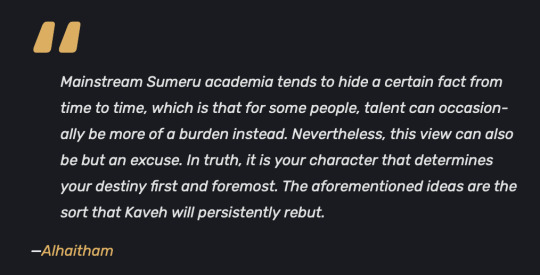
Kaveh will disagree with the two ideas his roommate mentions:
The labeling of certain students within the learning institution he attended as talented geniuses because of the pressure that comes with such titles
A persons character is the primary driver of their destiny
From the perspective of a maid, who's arc starts out as essentially a pushover, they would see eye to eye with Kaveh's stance.
A maid's character arc starts out with them being subjected to circumstances that fit them into rigid paths in which they have little to no control over and are shoved around by their aspect.
Maid of Time Aradia is introduced as already dead with the voices of the deceased ringing in her head and is the reason why her planet's apocalypse is destined to happen.
Maid of Life Jane was already on a predetermined path to become an heiress to a corporation that took up almost every aspect of her life.
And fellow Maid of Space Porrim in which due to her caste and gender was expected to care for the mother grub and tend to her species' young in the caverns for all of her life.
What if at a young age Kaveh displayed an aptitude for both the arts and mathematics, two sides of the Space aspect and the foundations for his profession as an architect, yet only the math side was found more appealing to Sumeru's society. Likely he had to suppress his artistic side and pursued STEM subjects such as physics and engineering in order to gain approval from the environment he grew up in.
Him being labeled as a genius may have added to this rigidness, pressuring him to keep on this path of lines and numbers instead of practicing crafts that he also could have exhibited talent in too.
This also does factor in to his roleplay as a Maid of Light, but that's a topic of conversation I want to discuss later.
Then, there is the topic of the The Palace of Alcazarzaray.

Kaveh's magnum opus.
A grand palace that was built for a character named Dori, whom of which admires Kaveh for being different from the others at the Akademiya, that allowed him to fully express his values of artistry and aesthetics, as well as gave something that he could be remembered by,
only for it to be the reason why he owes Dori such a massive amount of debt, ultimately being the reason why he's still in Sumeru. In order to be able to pay it off, it can be assumed that Kaveh has to take up many commissions and projects and work on them nonstop.
How would Kaveh's placement in Genshin currently be vital in the story?
Remember how a Maid's role could be that they fix a part of their aspect that's broken?
Space can relate to one's existence in a place, their environment. And currently, Kaveh's environment does not seem to be suited to those artistically inclined. Perhaps he could confront the stigma against it, rectify it and make Sumeru more welcoming to the joys of many different forms of art and how it can generate a different kind of wisdom that wouldn't have been conceived from the Akademiya's current view of it.
Maybe a story quest with him and another certain character overcoming their nation's flaw would be nice to experience

putting the hypothetical aside, Kaveh already is making and effort to change his environment long before we even see him for the first time.

Sumeru has a google-like device called the Akasha system where anyone can look up anything and learn skills from it that they previously didn't know. In here, it can be seen that it can render jobs obsolete and experience worthless.
This greatly upsets Kaveh, offering to defer his client to some maintenance workers so that their skills could be put to good use and still be able to make money from it. This essentially helps fix their livelihoods.
And if you ask his roommate why he would do such a thing:


This concludes the Maid of Space Kaveh analysis. Again apologies if it ends up a being a messy read! this was fun to do and im likely to make another one soon.
Maybe i can talk more about his roommate alhaitham and how the aspect light affects them both.
#homestuck#classpects#classpect analysis#godtiers#maid of space#genshin#genshin impact#genshin alhaitham#genshin kaveh#alhaitham#kaveh#ough its 4 am#I am so certain there are parts of him I’ve 4gotten 2 add#but alas#the human need 2 take a sleep
24 notes
·
View notes
Text
For millennia, the invention of writing has been heralded as a characteristic of civilization. Standard world-history texts name it -- along with monumental architecture, occupational specialization, and central governance -- as definitional. The new technology that associated symbols with sounds and numbers enabled specialists to record, communicate, and govern more efficiently. Ethnologists [...] discuss how writing facilitated census-taking, tax collection, the codification of law, governmental elaboration and centralization, and communication over long distances. Literacy became the basis for the transmission of the past and the development of modern historical consciousness in general (Howe 1979).
Written records, then -- such as those in cuneiform, inscribed on clay tablets; those left on a stone stele like Hammurabi’s Code; and the first to be written on papyrus or paper -- became in time the bedrock sources for fixating memories and constructing histories. Without a written record of events, recollections might, it was assumed, be abandoned to oblivion (Burke 1989, 97). Time and dates became the convention that societies used to order actions, resulting in a linear sequence of events and the organizational principle for much of the historical accounts. This also meant that for most of the documented past, historians dealt with the stories of leaders, elites, and heroes, which only in the last few decades have been supplemented with attention to the experiences of common people and everyday life.
---
Memories and identity link dialectically. Recollections of the past, be they of individuals, families, lineages, ethnicities, or nationalities, learned or experienced, help fashion identities [...]. [M]uch of the modern world’s historical sense comes from written sources stored in the libraries and archives of the world. Selections from these sources are conveyed to various publics through such institutions as movies, documentaries, commemorative monuments, museums, parades, ceremonies, and schools.
Accepting this posture in the not too distant past, scholars described preliterate peoples as societies without history. Archaeologists’ use of the word “prehistory,” though now slowly disappearing from academic publications, defined people who left no written records [...]. Eric Wolf’s famous book title, Europe and the Peoples without History (1982), referred to societies on the periphery of Europe [...]. Angel Rama’s (1984/1996) influential essay on the “lettered city” restricted the written record to urban centers, largely beyond the reach of the vast majority of the rural, largely unlettered populace.
---
In partial reaction to such pronouncements, recent scholarship has focused on alternative ways of recording and remembering the past. There are, in fact, many ways that [...] societies accomplished this. Chapters in Elizabeth Hill Boone and Walter Mignolo’s edited work, Writing without Words: Alternative Literacies in Mesoamerica and the Andes (1994), draw attention to visual documents and the messages they convey. Following this lead, Joanne Rappaport and Thomas Cummins’s book (2012) includes analyses of drawings (on pottery, for example) and a discussion of paintings as alternative means of communication by peoples without a written language. An example of this emerging trend on the topic is Chilean anthropologist José Luis Martínez Cereceda’s (2009) insightful article on the scattered petroglyphs of northern Chile, which, after an exhaustive survey, he characterizes as a recognized system of early communication.
Oral tradition is another alternative way of communicating (Thompson 1978). Among the Greeks, the time-honored tradition of oral storytelling conveyed knowledge to both young and old at family and community gatherings. [...] The Greek epic poems, the Iliad and the Odyssey, both attributed to Homer, were orally conveyed (Edwards 2003) before appearing in written form in the eighth century BCE. As in the case of the Greeks, the Norse oral culture passed from generation to generation in long poetic sagas. [...] Topics were historical, legendary, and religious and revealed attitudes toward the past. [...] Anonymous Icelandic family sagas (Íslendingasögur) retold the tales of real people who lived in Iceland from its settlement in the 980s until about 1030 (Byock 1984–85, 153). Like their Scandinavian counterparts, medieval Gaelic and British professional storytellers added music to the verses they composed.
---
Text by: Susan Elizabeth Ramirez. From Chapter One: “Alternative Ways of Remembering and Knowing.” In Praise of the Ancestors: Names, Identity, and Memory in Africa and the Americas. 2022. [Bolded emphasis added by me.]
36 notes
·
View notes
Note
Happy WBW! Would you say that there were main historical events that shaped the world your characters live in? If not, what were the commonplace events that most changed it through time?
Happy WBW! Thanks for the ask, though I know you sent it last week!
Well, you've awakened the history nerd in me, because my WIP is essentially alternate history. Within the story, I kept it very minimal for fear of boring people, but here it is fully explained:
We can assume that events that led to worldwide institutional slavery were analogous to the Depression and WWII and happened around the same time, although they didn't play out the way they did in our world. The Depression lasted many years longer to the point where it had wiped out all the wealth of the middle classes as well as the poor worldwide and caused such widespread misery that it led to the drastic measure of governments all over the world allowing people to sell their children and in some cases themselves into slavery to the rich in order to cover their debts and avoid starvation and death.
At the time, most people thought of it as a compassionate measure, one that was only meant to be temporary -- something more akin to indentured servitude than outright slavery. Except, after a few years, that mass influx of unpaid labor was then thought to have boosted the economy to the point that when the war started, it was able to be won swiftly and decisively by the countries who considered themselves to be, ironically, fighting for freedom, and presumably avoiding mass casualties and/or the use of nuclear weapons. Not to mention, once corporations got a taste for being able to exploit their workers with no consequence, they were loathe to give it up, so they lobbied to pass laws like partus sequitur ventrem, a law with origins in antiquity that declared that the child of a slave mother is born a slave.
So then an emergency government measure that was only meant to be temporary led to generations of people born and raised in slavery, because, hey, why mess with a system that had seemed to prevent the entire world from collapsing? As Corey put it, "It was either that or we'd ALL be slaves."
Since the war played out differently, the Cold War and the postwar economic boom also didn't happen, so we can also assume the countercultural revolution of the 1960s -- which arose as a backlash to those eras -- didn't happen, either, which can explain the strong undercurrents of sexism and sex-negativity we still see at play. And it's why my rule is to not include any real-world pop culture that came about post-1950 since I imagine that with all of the above, pop culture shaped up very differently. And by keeping that stuff out, it also cements the notion that this is not really "our" world, but merely one that shares some things with it (geography, fashion, vocabulary, and technology [except social media, because having done some YA I'm fucking sick of writing about social media, so I've decided it doesn't exist, sorry Tumblr🤣]. In many cases, national identities, borders, and governments are also not as we know them, which is why I don't reference things like presidents or prime ministers or Congress or even government departments like the FBI or the IRS (yes, these come up), because we can assume that stuff looks very different as well, though it's not really worth getting into.
There you go. If anyone's still here and awake after attempting to read all of that, have a cookie. 🍪
10 notes
·
View notes
Text

Stepping into STEAM Education: Unveiling the Power of Sneakers
In the world of education, innovation knows no bounds. Imagine a classroom where the rhythm of footsteps intertwines with the melody of learning, where sneakers become more than just fashion statements – they become educational tools.
Exploring the Data
Let's start by delving into the statistics that showcase the potential impact of incorporating sneakers into STEAM lessons. According to a study conducted by the National Center for Education Statistics, hands-on learning experiences, like those involving tangible objects such as sneakers, enhance student engagement and retention rates. The tactile nature of sneakers can serve as a gateway to various STEAM concepts, making learning a dynamic and memorable experience.
STEAM Lessons in Every Step
Breaking down the silos between subjects, sneakers become versatile teaching tools. For instance, the anatomy of a sneaker offers a real-world application for biology lessons. Students can explore the materials used, understand the biomechanics of comfort, and even dive into the environmental implications of manufacturing processes.
Utilizing technology, students can explore the engineering behind sneaker design. 3D modeling, prototyping, and understanding the physics of shoe performance become integral components of the lesson plan. Data from the Bureau of Labor Statistics emphasizing the growing demand for STEM-related occupations adds weight to the argument for embedding these concepts early in education.
The Artistry Beyond Aesthetics
Beyond the technical, sneakers embody an art form that bridges the gap between creativity and education. Visual arts classes can explore design principles, color theory, and cultural influences through the lens of sneaker culture. Drawing on sources like The Fashion Institute of Technology, we can illustrate how sneakers serve as a canvas for self-expression and cultural representation.
CommUNITY and Collaboration
Sneakers also facilitate collaboration and teamwork, vital skills in the professional world. Data from the P21 organization highlights the importance of fostering skills like collaboration, critical thinking, and creativity, all of which are inherent in the STEAM-infused sneaker education model.
As we lace up our sneakers and step into the future of education, the integration of STEAM principles becomes a thrilling adventure. The statistics and data speak volumes about the potential impact on student engagement, skill development, and the cultivation of a generation ready to stride confidently into a STEAM-powered world.

#solecial studies#education#kickstory#osdlive#sneakers#obsessivesneakerdisorder#hiphop#knowledge#brooklyn#houston#usvi#fashion
2 notes
·
View notes